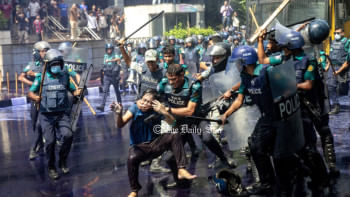Same people; change only in party name
It may sound like a fiction, but it's all true.
This is the story of how a student organisation turned into a killing squad in 1971, the role of its leaders and activists in the killing of intellectuals and its rebirth in an independent country that it vigorously opposed.
The members of Islami Chhatra Sangha (ICS), the then student wing of Jamaat-e-Islami, turned into militiamen of ferocious Al-Badr Bahini and killed several hundred intellectuals towards the end of the Liberation War.
After the victory on December 16, 1971, the government's decision to ban five communal parties including Jamaat-e-Islami resulted in the halt to Islami Chhatra Sangha's operations.
The fate of Jamaat as well as its student wing changed a lot after the assassination of Bangabandhu Sheikh Mujibur Rahman whose government had banned religion-based politics.
Jamaat took the opportunity to regroup following the withdrawal of the ban by the Ziaur Rahman regime.
It gained strength during the martial law regime and the democratic government rule in the 90s. It even managed to taste state power.
Top Jamaat leaders Motiur Rahman Nizami and Ali Ahsan Mohammad Mojaheed, who were at the helm of Islami Chhatra Sangha in 1971, became ministers during the tenure of the last BNP-led government.
How the Al-Badr, an auxiliary force of Pakistani army, was formed and had links with Chhatra Sangha was delineated by a report of Dainik Sangram, Jamaat's mouthpiece.
The report, published on September 14, 1971, says the Al-Badr force was formed under the leadership of Mohammad Ashraf Hossain, the then president of Momensahi (Mymensingh) Islami Chhatra Sangha, immediately after the Pakistani army had entered Jamalpur on April 22, 1971.
The report mentioned many Al-Badr operations in greater Mymensingh, where they killed huge numbers of freedom fighters. Later the force expanded operations all over the country.
A book by Mohi Uddin Chowdhury, the then leader of Jamaat as well as the Noakhali Peace Committee in 1971, shows the links between Chhatra Sangha and Al-Badr.
Published in 1998, the book Sunset at Midday says, “The workers belonging purely to Islami Chhatra Sangha were called Al-Badr, the general patriotic public belonging to Jamaat-e-Islami, Muslim League, Nizam-e-Islami, etc, were called Al-Shams and the Urdu-speaking generally known as Bihari were called al-Mujahid.”
Reports of post-liberation newspapers show Jamaat's links with the infamous Al-Badr force and its role in the killing of intellectuals.
The Observer on December 21, 1971, reported Al-Badr as “the fascist armed gangsters who had close political affiliation with the ultra-rightist Jamaat-e-Islami, a boot-licking political force of the Pakistani army.”
Dainik Purbadesh on December 18, 1971, said the Al-Badr force was formed with the “heinous killers of fascist Jamaat-e-Islami, which was backed by the Pakistani army”.
Even some foreign newspapers wrote about the connections between Al-Badr and Jamaat.
On January 3, 1972, the New York Times reported, “Al Badr is believed to have been the action section of Jamaat-e-Islami, carefully organised after the Pakistani crackdown last March.”
The previous verdicts of the war crimes tribunals also restated the fact.
In its verdict in Mojaheed's case on July 17, International Crimes Tribunal-2 observed that Mojaheed, who was the president of East Pakistan ICS in 1971, had held a superior position in the Al-Badr force.
The court gave Mojaheed death penalty for the killing of intellectuals during the war of independence.
In its verdict yesterday, the tribunal said the Jamaat-e-Islami had played “a culpable role in liquidating the notable pro-liberation intellectuals, the best sons and daughters of the soil, by providing express and active approval to the killing squad formed of Al-Badr men who in fact belonged to ICS”.
Terming Al-Badr a brainchild of Jamaat, the tribunal observed, "It is now settled that the Al-Badr, the 'action section' of JEI [Jamaat-e-Islami] was formed of the workers of ICS [Islami Chhatra Sangha]."
The Islami Chhatra Sangha was reborn in February 1977 with the name of Islami Chhatra Shibir, and most of the Chhatra Sangha leaders became active with it, while the former's senior members joined its mother organisation Jamaat-e-Islami.
However, Jamaat has always denied Shibir's links with the Chhatra Sangha.
According to a book titled Ekattorer Ghatak O Dalalra Ke Kothay (1987), there was no difference between the Chhatra Shibir and the Islami Chhatra Sangha except in a part of the name. The organisation replaced the “Sangha” part of their name with “Shibir”. The prosecution used the book as evidence in many war crimes cases in the tribunals.
The term Shibir was taken from the name of the junior branch of the Sangha, “Shaheen Shibir”. Apart from this change in nomenclature, everything else, including the flag and the monogram, remained the same, the book says.
Mir Quasem Ali, who became the first president of Shibir in 1977, was the general secretary of East Pakistan Islami Chhatra Sangha in the last part of 1971. Convicted Al-Badr leader Muhammad Kamaruzzaman, the second president of Shibir, was a top leader of Chhatra Sangha in Mymensingh in 1971, the book adds.
Motiur Rahman Nizami, who was the president of East Pakistani ICS until October 1971, and Mojaheed, who became the successor to Nizami, joined Jamaat after it rejoined politics in 1977 in Bangladesh. Nizami and Quasem are now facing similar war crimes charges.
Shibir repeatedly came under the spotlight for killing their rivals and cutting their tendons, a unique style introduced by the Shibir in the 1980s. Jamaat-Shibir men have resorted to violence on many occasions since then, including when Jamaat leader Delawar Hossain Sayedee was sentenced to death.

 For all latest news, follow The Daily Star's Google News channel.
For all latest news, follow The Daily Star's Google News channel. 



Comments